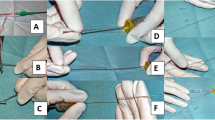Abstract
Purpose
The objectives of this study were to determine the effects of expanded polytetrafluoroethylene (PTFE)-covered stent location and TIPS extension on primary patency.
Methods
This retrospective cohort study examined patients with PTFE-covered TIPS creation between 07/2002 and 06/2016. Clinical information and patency outcomes at 24 months were extracted. At TIPS creation, extension was performed at the discretion of the operator. Kaplan–Meier curves of primary patency were generated with conditional variables of HVO-HCJ distance, extension status, and covered versus uncovered extensions. Additional logistic regression analyses of distances were performed.
Results
Of 393 patients, 115 patients (29%) underwent stent extension, 79 (20% of total cohort) of which were at the HVO end alone. Primary patency for all TIPS was 75%, 68%, and 54% at 3, 6, and 12 months. The data endpoint were transplant or death in 92 (23%) and 116 (30%). Kaplan–Meier curves showed no statistically significant difference between the variables and primary patency at 12 and 24 months: distance up to versus greater than 10 mm (p = 0.32, 0.81); extension versus no extension (p = 0.83, 0.85); uncovered versus covered extensions (p = 0.58, 0.70). Logistic regression analyses showed a trend toward statistical significance.
Conclusion
In the setting of PTFE-covered TIPS creation, extended TIPSs and unextended well-positioned TIPSs have no difference in primary patency rates. Stent position and extension length may have an effect on primary patency, but were likely obscured by “user recognition” effects.



Similar content being viewed by others
Data availability
All data generated or analyzed during this study are not publicly available due to identifiable patient information but are available in the departmental quality assurance database.
References
Boyer TD, Haskal ZJ, American Association for the Study of Liver D. The Role of Transjugular Intrahepatic Portosystemic Shunt (TIPS) in the Management of Portal Hypertension: update 2009. Hepatology 2010;51:306. https://doi.org/10.1002/hep.23383.
Qi X, Han G, He C, Yin Z, Zhang H, Wang J, et al. Transjugular intrahepatic portosystemic shunt may be superior to conservative therapy for variceal rebleeding in cirrhotic patients with non-tumoral portal vein thrombosis: a hypothesis. Med Sci Monit 2012;18:HY37–41.
Barrio J, Ripoll C, Banares R, Echenagusia A, Catalina M V, Camunez F, et al. Comparison of transjugular intrahepatic portosystemic shunt dysfunction in PTFE-covered stent-grafts versus bare stents. Eur J Radiol 2005;55:120–4. https://doi.org/10.1016/j.ejrad.2004.10.007.
Weber CN, Nadolski GJ, White SB, Clark TW, Mondschein JI, Stavropoulos SW, et al. Long-Term Patency and Clinical Analysis of Expanded Polytetrafluoroethylene-Covered Transjugular Intrahepatic Portosystemic Shunt Stent Grafts. J Vasc Interv Radiol 2015;26:1257–65; quiz 1265. https://doi.org/10.1016/j.jvir.2015.04.005.
Clark TW, Agarwal R, Haskal ZJ, Stavropoulos SW. The effect of initial shunt outflow position on patency of transjugular intrahepatic portosystemic shunts. J Vasc Interv Radiol 2004;15:147–52.
Bai M, He CY, Qi XS, Yin ZX, Wang JH, Guo WG, et al. Shunting branch of portal vein and stent position predict survival after transjugular intrahepatic portosystemic shunt. World J Gastroenterol 2014;20:774–85. https://doi.org/10.3748/wjg.v20.i3.774.
Luo SH, Chu JG, Huang H, Yao KC. Effect of initial stent position on patency of transjugular intrahepatic portosystemic shunt. World J Gastroenterol 2017;23:4779–87. https://doi.org/10.3748/wjg.v23.i26.4779.
Clark TW. Stepwise placement of a transjugular intrahepatic portosystemic shunt endograft. Tech Vasc Interv Radiol 2008;11:208–11. https://doi.org/10.1053/j.tvir.2009.04.002.
Andring B, Kalva SP, Sutphin P, Srinivasa R, Anene A, Burrell M, et al. Effect of technical parameters on transjugular intrahepatic portosystemic shunts utilizing stent grafts. World J Gastroenterol 2015;21:8110–7. https://doi.org/10.3748/wjg.v21.i26.8110.
LaBerge JM, Somberg KA, Lake JR, Gordon RL, Kerlan Jr. RK, Ascher NL, et al. Two-year outcome following transjugular intrahepatic portosystemic shunt for variceal bleeding: results in 90 patients. Gastroenterology 1995;108:1143–51.
Sze DY, Vestring T, Liddell RP, Kato N, Semba CP, Razavi MK, et al. Recurrent TIPS failure associated with biliary fistulae: treatment with PTFE-covered stents. Cardiovasc Interv Radiol 1999;22:298–304.
Ducoin H, El-Khoury J, Rousseau H, Barange K, Peron JM, Pierragi MT, et al. Histopathologic analysis of transjugular intrahepatic portosystemic shunts. Hepatology 1997;25:1064–9. https://doi.org/10.1002/hep.510250503.
Huang Q, Wu X, Fan X, Cao J, Han J, Xu L, et al. Comparison study of Doppler ultrasound surveillance of expanded polytetrafluoroethylene-covered stent versus bare stent in transjugular intrahepatic portosystemic shunt. J Clin Ultrasound 2010;38:353–60. https://doi.org/10.1002/jcu.20709.
Marin ML, Veith FJ, Cynamon J, Parsons RE, Lyon RT, Suggs WD, et al. Effect of polytetrafluoroethylene covering of Palmaz stents on the development of intimal hyperplasia in human iliac arteries. J Vasc Interv Radiol 1996;7:651–6.
Klasen-Sansone J, Bode J, Lanzman RS, Kubitz R, Immig S, Heusch P, et al. TIPS geometry influences patency. Z Gastroenterol 2015;53:28–32. https://doi.org/10.1055/s-0034-1385430.
Funding
This study was not supported by any funding.
Author information
Authors and Affiliations
Corresponding author
Ethics declarations
Conflict of interest
Joshua K. Cho, MD: None, Juan Serna: None, Timothy W. I. Clark, MD: Consultant—Teleflex, Becton Dickinson, B. Braun; Royalties—Teleflex, Merit, Mandeep Dagli, MD: None, Jeffrey I. Mondschein, MD: None, Richard D. Shlansky-Goldberg, MD: None, Scott O. Trerotola, MD: Consultant—WL Gore, Cook, MedComp, Teleflex, BD Bard, Adrenas; Royalty—Cook, Teleflex, Michael C. Soulen, MD: Research grant—Guerbet LLC, BTG International, Sirtex Medical; Consultant—Guerbet LLC, Genentech, S. William Stavropoulos, MD: Research grant—Sillajen, Cook; Consultant—Becton Dickinson, Gregory J. Nadolski, MD: None.
Ethical approval
All procedures performed in this study involving human participants were in accordance with the ethical standards of the institutional and/or national research committee and with the 1964 Helsinki declaration and its later amendments or comparable ethical standards.
Additional information
Publisher's Note
Springer Nature remains neutral with regard to jurisdictional claims in published maps and institutional affiliations.
Rights and permissions
About this article
Cite this article
Cho, J.K., Serna, J., Clark, T.W.I. et al. Impact of PTFE-covered stent position and extension on TIPS patency. Abdom Radiol 45, 3915–3922 (2020). https://doi.org/10.1007/s00261-020-02566-8
Published:
Issue Date:
DOI: https://doi.org/10.1007/s00261-020-02566-8




